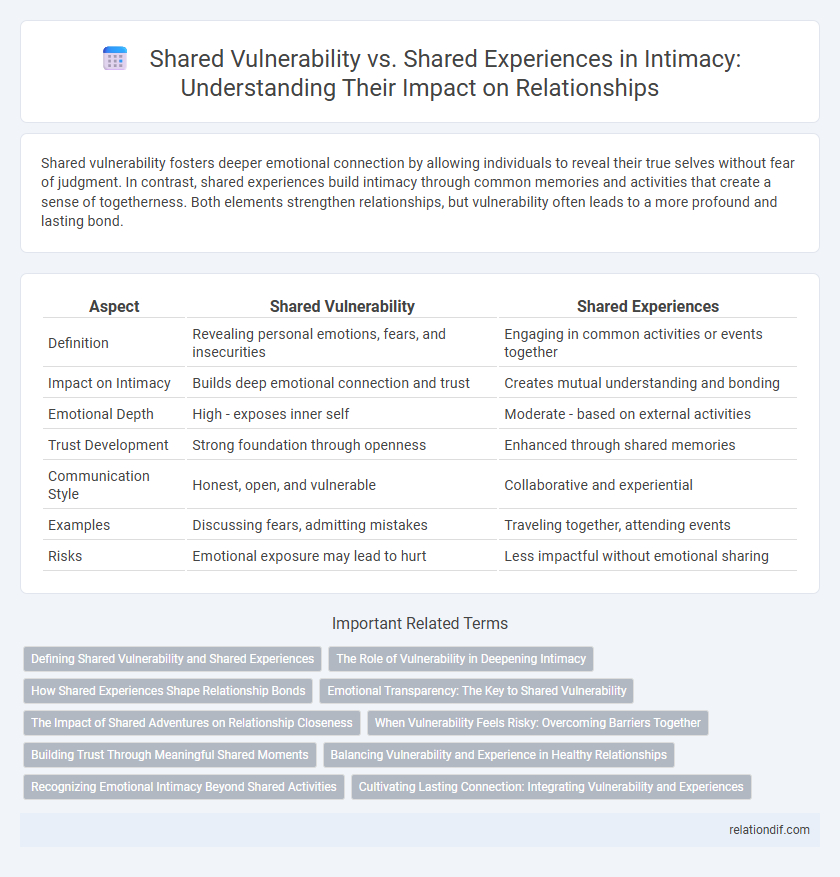Shared vulnerability fosters deeper emotional connection by allowing individuals to reveal their true selves without fear of judgment. In contrast, shared experiences build intimacy through common memories and activities that create a sense of togetherness. Both elements strengthen relationships, but vulnerability often leads to a more profound and lasting bond.
Table of Comparison
| Aspect | Shared Vulnerability | Shared Experiences |
|---|---|---|
| Definition | Revealing personal emotions, fears, and insecurities | Engaging in common activities or events together |
| Impact on Intimacy | Builds deep emotional connection and trust | Creates mutual understanding and bonding |
| Emotional Depth | High - exposes inner self | Moderate - based on external activities |
| Trust Development | Strong foundation through openness | Enhanced through shared memories |
| Communication Style | Honest, open, and vulnerable | Collaborative and experiential |
| Examples | Discussing fears, admitting mistakes | Traveling together, attending events |
| Risks | Emotional exposure may lead to hurt | Less impactful without emotional sharing |
Defining Shared Vulnerability and Shared Experiences
Shared vulnerability involves openly expressing fears, insecurities, and authentic emotions, creating a deep emotional connection based on honesty and trust. Shared experiences refer to participating together in activities or events, fostering bonds through mutual memories and external contexts. Both elements serve as pillars in intimacy, with vulnerability building emotional depth and shared experiences enhancing relational continuity.
The Role of Vulnerability in Deepening Intimacy
The role of vulnerability in deepening intimacy lies in its power to create authentic emotional connections through openness and trust, allowing partners to reveal their true selves beyond surface interactions. Shared vulnerability fosters empathy and mutual understanding, strengthening the emotional bond more profoundly than simply sharing experiences. This emotional exposure cultivates a safe space where intimacy thrives, promoting deeper relational satisfaction and resilience.
How Shared Experiences Shape Relationship Bonds
Shared experiences create a foundation of mutual understanding and trust, strengthening the emotional connection between partners. Engaging in activities or overcoming challenges together fosters a sense of unity and co-dependence that deepens intimacy. These collective moments become pivotal memories that continuously reinforce the relationship's resilience and closeness.
Emotional Transparency: The Key to Shared Vulnerability
Emotional transparency fosters shared vulnerability by allowing individuals to express their true feelings without fear of judgment, deepening trust and connection. Unlike shared experiences, which build common ground through external events, emotional transparency dives into internal realities, nurturing authenticity and mutual understanding. This openness is the cornerstone of intimate relationships, enabling partners to support each other's emotional needs profoundly.
The Impact of Shared Adventures on Relationship Closeness
Shared adventures foster relationship closeness by creating unique memories that bond partners through novel and exciting experiences. Engaging in challenging activities together enhances trust, communication, and emotional connection, surpassing the effects of mere shared experiences. This dynamic vulnerability strengthens intimacy by encouraging mutual support and collaboration in unfamiliar situations.
When Vulnerability Feels Risky: Overcoming Barriers Together
Shared vulnerability deepens intimacy by creating a safe space for authentic emotional expression, fostering trust even when feelings feel risky or uncertain. Overcoming barriers involves recognizing fears tied to rejection or judgment and actively supporting each other's courage to be open. Embracing vulnerability as a mutual strength transforms shared experiences into profound connections that build resilience in relationships.
Building Trust Through Meaningful Shared Moments
Building trust in intimacy thrives on meaningful shared moments that foster vulnerability and genuine connection. When partners openly express fears, dreams, and feelings, they create a safe space where mutual understanding deepens. These authentic exchanges strengthen emotional bonds far more effectively than simply accumulating shared experiences without emotional openness.
Balancing Vulnerability and Experience in Healthy Relationships
Balancing shared vulnerability and shared experiences is essential for cultivating healthy intimacy, as vulnerability fosters emotional trust while shared experiences create lasting bonds. Partners who openly express fears and insecurities deepen their connection, whereas engaging in meaningful activities together strengthens mutual understanding and support. Integrating both elements ensures a resilient relationship built on authenticity and mutual growth.
Recognizing Emotional Intimacy Beyond Shared Activities
Emotional intimacy deepens when individuals openly share vulnerabilities rather than merely participating in shared experiences. Recognizing emotional intimacy involves acknowledging trust, empathy, and authentic self-expression that go beyond common activities. This connection fosters a profound bond, strengthening relationships through mutual understanding and emotional safety.
Cultivating Lasting Connection: Integrating Vulnerability and Experiences
Cultivating lasting connection requires integrating both shared vulnerability and shared experiences, as vulnerability fosters emotional depth while shared experiences build trust and familiarity. Consistent openness about personal fears and feelings enhances intimacy by creating a safe space for mutual understanding. When couples balance these elements, they develop a resilient bond that thrives through empathy and meaningful moments.
shared vulnerability vs shared experiences Infographic

 relationdif.com
relationdif.com